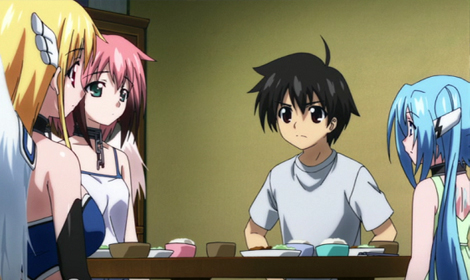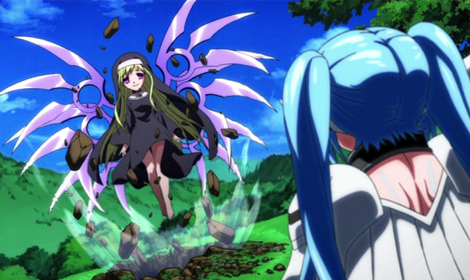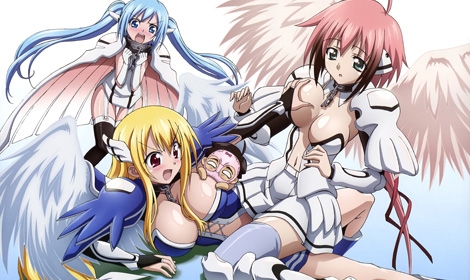A direct sequel to last year’s release of Heaven’s Lost Property, Heaven’s Lost Property: Forte is a great example of a sequel improving on the quality of the original. Much like Francis Coppola’s Godfather II, as fun and entertaining as the first series was, the sequel improves on it in both story and entertainment value.
When we last left the group, Nymph and Ikaros had just begun to get in touch with their human ”consciousness” by breaking away from their chains to the mysterious dictator of Synapse. With the perverted yet benevolent male lead Tomoki Sakurai helping them find a reason to live while giving them the motivation to find their own source of self-fulfillment, the leader of Synapse begins to develop an unhealthy infatuation with killing Tomoki and his friends. To accomplish this, he sends the ditsy close combat angeloid Astrea, the last of the first-generation series, to destroy them. However, despite her best attempts to defeat Tomoki, he ends up providing her much needed shelter and care just like the other two angeloids through a series of misadventures and accidents.
Skipping the Hiyori arc from the manga, which has been adapted into the full-blown movie Heaven’s Lost Property: the Angeloid of Clockwork, the series instead goes directly to the much more action oriented Chaos arc. Having lost the entire first-generation set of angeloids, the mysterious dictator decides to unleash the very capable second-generation Chaos to destroy the downers, starting with Tomoki; which, coincidentally, is where the real focus of the second thirteen episode season takes place, taking a whole half of a season to resolve.
With all three first-generation angeloids having to work together to fight against a larger single threat, the second season has a frantic, heavy, mech action approach that was never present in its predecessor. I personally had no qualms about the decision to focus on action as seeing the characters grow through the first season allowed me to care about their plights that much more. Additionally, it allowed the series to distance itself a bit from drawing heavy comparisons to Chobits.

Meanwhile, as the angeloids wage war, Eishiro and the rest of the “New World” gang finally get their first glimpse of Synapse, realizing the threat that the elitist world presents to humans which I presume will be the main focus for the recently announced season three.
However, for those of you who enjoyed the somewhat pro-feminist theme in season one of finding independence by breaking away from the chains of your male master, be advised that the message is much more subdued in season two. Only Astrea learns what it takes to become an independent woman capable of making her own choices, and it happens so quickly that it’s easy for it to get lost in the shuffle.
Instead, what we have in season two is the much more traditional harem style themes of marriage and love. Can a human being fall in love with a mythical sentient being who wasn’t born on Earth and was intended as a weapon of war? Yes, this extra storyline is incredibly predictable if you’ve seen almost any other series involving a robot and human, but it’s still an entertaining diversion from the primary storyline. Ultimately, this issue never fully resolves in season two, and with both Ikaros and Nymph spending almost the entirety of the season head over heel in love with Tomoki, it probably won’t be resolved until season three. Not to mention that there’s the possibility of top-heavy Astrea joining them to draw out an almighty love pentagon.

Just like the first season, you can expect a lot of the returning elements that make Heaven’s Lost Property such a simple joy to watch. The timely match between each of the episode’s more heartfelt moments along with its extreme pervasive humor, including what I personally like to call “March of the Ero,” and unique ending themes appropriate for each episode both return guided by director Hisashi Saito with animation by AIC. While the new opening, “Heart no Kakuritsu” by Blue Drops, who also sang a majority of the closing themes, is a pleasant song it still doesn’t compare to the much more memorable song “Ring my Bell” from season one. In one of my favorite moments of the entire season, we have an unexpected twist with Tomoki singing the theme in the first episode which sets a fun ambiance for the rest of the series.
As much as I enjoyed season two though, there are two major flaws that prevents Forte from becoming a very solid recommendation to harem fans: firstly, the second season isn’t very friendly to newcomers with a lack of any recap episodes or refreshers and secondly, the fact that the release is currently DVD only. Although this had to do with the response on the Japanese corporate side that the overseas sales would draw sales away from the very recently released second season on Blu-ray in Japan, fans who purchased the first season to enjoy the high-definition release may want to stay away.
For fans of special features, the disc is limited to your typical FUNimation extras including textless opening and ending themes along with short commentary from the creative directors in charge of the series. As with the first season, the textless closings are welcomed as they’re all unique and very story centric.
Overall, if you enjoyed season one, season two is a slightly improved, if not predictable, sequel to Heaven’s Lost Property. Sure, some of the messages from the first season fall completely flat on their face by the end of the second season, but fans of the series knew what they were getting into when they watching the series. It’s a harem fair and simple, and sometimes that’s all we need.
![]()
Two things I loved:
+ Nymph, Nymph, Nymph. What, you want to go, Ikaros fans?
+ A well-balanced diet of ecchi jokes and action, with the occasional heartfelt moment.
Two things I hated:
- No matter how entertaining I might find them, the series has begun to meander its way into typical, predictable harem tropes.
- DVD-only release drops the overall rating down by a few points.
Disclosure: A review copy was provided by the distributor, Images copyrighted:FUNimation/AIC

